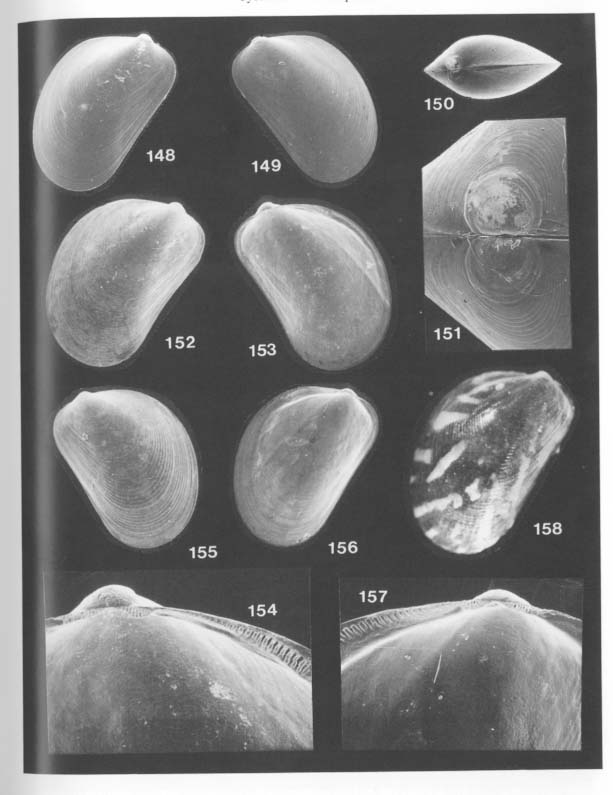Systematic Description
Dacrydium zebra sp. nov.
|
  |
1992. Dacrydium sp., Kase and Hayami,Jour. Moll. Studies, vol.58, p.448, listed.
1993. Dacrydium sp., Hayami and Kase, Univ. Mus. Univ. Tokyo, Nezws, no.27, p.3, fig.7.
Type and material.—Holotype: RM19432a, a living specimen, from the bottom sediments of "Devil's Palace" of Shimoji Islet, Miyako Islands. Paratypes: RM19432 (living) from the type locality, RM19433 (living) from "Fool's Palace", RM19434 (living) from "Witch's House", RM19592 (living) from "Wall Cave", RM19435 (living) from "Toriike", RM19436 (living) from "Black Hole", RM19591 (dead) from "Coral Hole" of Shimoji Islet. RM19437 (dead) from "Lunch Hole", RM19438 (living) from "W-arch", RM19439 (dead) from "L-arch", RM19440 (living) from "Cross Hole" of Irabu Islet. RM19441 (living) from "Shodokutsu" of Ie Islet.
Diagnosis.—Small-sized brooding species of Dacrydium, characterized by pyriform outline, arcuate dorsal margin, straight or slightly concave anterior margin, persistent denticles derived from provinculum which are differentiated into pre-umbonal, post-umbonal and posterior series, dense commarginal lamellae and commonly whitish opaque spots.
Description.—Shell smaller than 2.3 mm in length and height, with maximum length about 1.4 times transverse breadth, obliquely pyriform, translucent, very thin, moderately inflated. Umbo moderately large, salient above dorsal margin. Anterior lobe obscurely discriminated. Dorsal margin broadly arcuate; anterior margin nearly straight or slightly concave, forming a near rectangle with anterior part of dorsal margin; ventral and posterior margins rounded, not discriminated from each other. Surface covered with numerous densely spaced commarginal lamellae. Early dissoconch marked faint divergent threads perpendicularly crossing growth lines. Later dissoconch often has several whitish opaque spots which are divergent from growth axis. Anterior adductor scar distinct, pear-shaped, not degenerated; posterior one obscurely impressed but probably smaller than anterior. Pre-umbonal denticles short but not much degenerated, numbering about 10. Post-umbonal denticles differ-entiated into two rows; denticles of the anterior row nearly vertical, short and disposed nearly symmetrically with the pre-umbonal denticles, while the posterior row consists of about 30 opisthoclinal denticles, increasing in length posteriorly, well developed on a plate between dorsal margin and internal ridge. Primary ligament persistent; pit acline, low and wide. Incipient secondary ligament probably present on the hinge plate between rows of post-umbonal and posterior denticles. Pd I large, ranging 176-225 µm in maximum diameter, with uneven surface; Pd II not demarcated.
Remarks.—Numerous individuals of the present species have been found attached by byssus on the sediment grains, polychaete tubes and walls in a number of caves of these islets.
More than a dozen species of Dacrydium have been known (Ockelmann, 1983; Poutiers, 1989). In the Japanese waters only a bathyal species, Dacrydium nipponicum Okutani, 1975 [=D. pacificum Okutani, 1968, non Dall, 1916], has been described, from which the present species differs in its smaller size, more sharply pointed anterior end and straight or feebly concave anterior margin. In these respects it may be closer to Dacrydium occidentale Smith, 1885, from the western Indian Ocean, and D. rostriferum Bernard, 1978, from the northeast Pacific.
Considering the intra- and interpopulational variations, the difference of shell shape from these bathyal-abyssal species is sometimes subtle. Yet the hinge structure of the present species may be unique; the denticles of the posterior series are well differentiated into two rows of different inclination (Figures 154, 157). According to Ockelmann (1983), however, similarly differentiated denticles are known in Dacrydium viviparum Ockelmann, 1983, from the northern Atlantic. In spite of the distant distributed areas, we regard the Atlantic species as closely related to the present species. Ockelmann interpreted the interruption of the posterior denticles as indicating the incipient development of a secondary ligament. Yoshida (1937, text-figs.3, 4) illustrated a somewhat similar hinge structure in the juvenile stage (0.6-1.0 mm in shell length) of Brachidontes senhoitsia (Benson, 1842), which is an ubiquitous embayment mussel in Japan.
In Dacrydium viviparum Ockelmann, 1983, suprabranchial incubation of a few embryos is known. This is also the case with the present species, though the Pd I is somewhat smaller than that of the Atlantic species. In the samples collected in late June of 1992 and mid April of 1993, several incubated embryos were seen through the translucent shell of many individuals generally larger than 1.5 mm in length. The divaricate whitish opaque spots are unfamiliar in Dacrydium. They look like a zebra pattern, when a disarticulated valve is placed on a dark stage (Figure 158).
Distribution.—Abundant or common in many sublittoral caves of Shimoji-Irabu and Ie Islets, Ryukyu Islands. This species also occurs in "Balicasag Cave" off Panglao Islet of Bohol Island, the Philippines.
Subfamily uncertain
Genus Urumella gen. nov.
Genus Urumella gen. nov.
Type-species.—Urumella concava sp. nov.
Diagnosis.—Small and uniquely distorted genus of Mytilidae, characterized by nacreous and very obliquely elongate shell, concave posterior margin, filmy periostracum, persistent denticles of provinculum, no adult teeth, and low-triangular primary ligament pit below umbo.
Etymology.—Uruma is another name of the Ryukyu Islands.
Remark.—This new genus is proposed on the basis of a diminutive cave species, the posterior margin of which is characteristically concave and incurved. It may belong to the Crenellinae, if the system by Soot-Ryen in Cox et al. (1969) is accepted. Since there is no other species assignable to this new genus, the diagnoses for the genus and species are by no means clearly separable. The ligament and hinge structure of this type-species seems to be paedomorphic, resembling that of Dacrydium, but the shell is nacreous, unlike the members of the Dacrydiinae. The argenteous shell and persistent denticles derived from the provinculum resemble those of some species of the genus Idas Jeffreys, 1876 (= Idasola Iredale, 1915), from deep waters of the Atlantic and northern Pacific, but the periostracum is hairy and the secondary external ligament is developed in Idas.